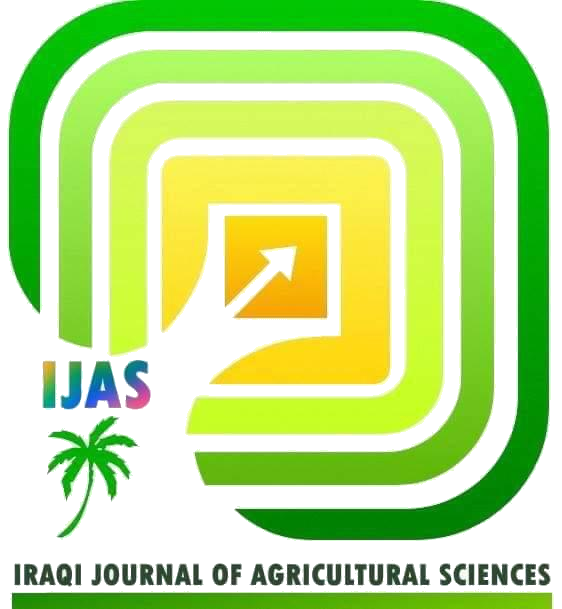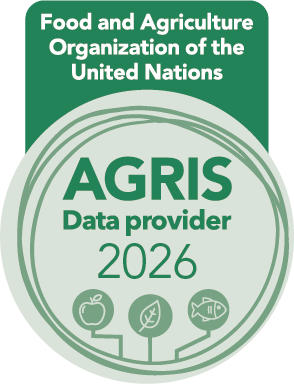PHYTOCHEMICAL IDENTIFICATION OF PELARGONIUM GRAVEOLENS L. AND STUDYING ITS BIOLOGICAL ACTIVITY
DOI:
https://doi.org/10.36103/akg6vq54Keywords:
Active compounds, antioxidant, extract.Abstract
This study was aimed to determine the active compounds in alcoholic extracts (methanolic 75% and ethanolic 75%) of Pelargonium gravolens leaves and flowers as well as their antibacterial and antioxidant activities. The methanolic extract of dry leaves and fresh flowers (30 g each) gave 4.8650, 2.8015 g respectively. While ethanolic extract for the same parts gave 5.5787, 2.1832g respectively. Spectrophotometric analysis showed that, the flavonoids content in leaves and flowers methanol extract were 20.38, 70.90 μg rutin equivalent/g of extract, respectively, as for ethanol extract those values were 21.89, 71.63 μg rutin equivalent/g of extract, respectively. According to the above findings, it has been noticed that the flowers ethanol extract recorded the highest value for flavonoids (71.63 μg rutin equivalent /g of extract). The results indicate that the free radical scavenging activity ( RSA) of ethanolic extract of the flowers and leaves was lower than that of methanolic extract. Where the RSA percentages of the leaves methanolic extract were (12, 13, 14, 16, 19 %) at a concentration (0.25, 0.50, 0.75, 1.00, 1.25 mg/ml) respectively, and for the flowers were (142, 162, 162) 164, 166%) at the same concentrations respectively.
References
1. Alara O. R.; A. Nour and C. I. Ukaegbu. 2018. Soxhlet extraction of phenolic compounds from Vernonia cinerea leaves and its antioxidant activity. J. of Applied Res. on Medicinal and Aromatic Plants. V. 11, pp. 12-17. DOI:10.1016/j.jarmap.2018.07.003
2. Ansari Prawej; A. D. Reberio ;N. J. Ansari; N. J. Ansari; S. Kumar ; J. T. Khan ; S. Chowdhury ; F. M. Abd El-Mordy ; and J. M. A. Hannan. 2024. Therapeutic Potential of Medicinal Plants and Their Phytoconstituents in Diabetes, Cancer, Infections, Cardiovascular Diseases, Inflammation and Gastrointestinal Disorders. Biomedicines. 13(2), 454; https://doi.org/10.3390/biomedicines13020454
3. Abd El-Rahman, A. A. A.; I. M. Abd El-Aleem,; L. A. Refahy and M. A. El-Shazly. 2016. Total phenolic content, cytotoxic and antioxidant activities of Quisqualisindica (Linn.) growing in Egypt. Der Pharma Chemica. 8 (3):53-59.
4. Al-Delaimy, K. S. and S. H. Ali. 1970. Antibacterial action of vegetable extract on the growth of pathogenic bacteria . J. Sci. Food Agric. 21:110-111. doi.org/10.1002 /jsfa. 2740210214
5. Ali Z. A. A.; M. H. Hadeel and A. J. Liqaa. 2022. Morphological, anatomical and chemical study of an exotic plant Jatropha integerrima jacq. 1763 (euphorbiaceae) in Iraq. Bull. Iraq nat. Hist. Mus. 17 (1): pp129-140. DOI: https ://doi.org/10.26842 /binhm. 7. 2022.17.1.0129
6. Al-Ezzy, R.M., M.H. Ahmed, H. M. Khalaf, 2024. In vivo study the cytogenetic effect of ammi majus methanolic extract on mitotic index, micronucleus formation and dna damage on mitoxantrone. Baghdad Science Journal, 21(8): 2522–2530. https://doi.org/10.21123/bsj.2024.9034
7. Al-Saffar A. Z.; A. F. Al-Shanon; S. L. Al-Brazanchi; F. A. Sabry; F. Hassan and N. A. Hadi. 2017. Phytochemical Analysis, Antioxidant and Cytotoxic Potentials of Pelargonium graveolens Extract in Human Breast Adenocarcinoma (MCF-7) Cell Line. Asian Journal of Biochemistry. 12 (1) :16-26. DOI: 10.3923/ajb.2017.16.26.
8. Boeing J. S. ; É. O. Barizão; B. C. Silva; P. F. Montanher; V. C. Almeida and J. V. Visentainer.2014. Evaluation of solvent effect on the extraction of phenolic compounds and antioxidant capacities from the berries: application of principal component analysis. Chemistry Central Journal. 8:48, pp 1-9.
9. Boukhris M. ; S. J. S. Monique ; S. Sami and B. Mohamed. 2012. Chemical composition and biological activities of polar extracts and essential oil of rose-scented geranium, Pelargonium graveolens. Phytotherapy Res. 27 (8) : 1206-1213. DOI: 10.1002/ptr.4853. Epub 2012 Oct 2.
10. Cervantes L.; M. Ariza; J.A. Gómez-Mora and L. M. Enamorado. 2019. Light exposure affects fruit quality in different strawberry cultivars under field conditions. Scientia Horticulturae 252(4):291-297. DOI:10.1016/j.scienta.2019.03.058.
11.Duffy C. F. and R. F. Power .2001. Antioxidant and antimicrobial properties of some Chinese plant extracts . Int. J. Anttimicrob. Agents, 17 : 527-529. DOI.org/10.1016/S0924-8579(01)00326-0.
12. Ekalu A. E. and J. D. Habila. 2020. Flavonoids: isolation, characterization, and health benefits. Beni-Suef University Journal of Basic and Applied Sciences. Volume 9, Article number: 45.DOI.org/10.1186/s43088-020-00065-9.
13. Feliciano R.P.; S. Pritzel ; C. Heiss and A. Rodriguez-Mateos. 2015. Flavonoid intake and cardiovascular disease risk. Curr. Opin. Food Sci. 2:92–99. DOI.org/10.101p /j. cofs. 2015.02.006
14. Ghedira K.; P. Goetz. 2015. Géranium rosat: Pelargonium graveolens L’Hér. (Géraniaceae). Phytotherapie. 13(3). DOI:10.1007/s10298-015-0955-x.
15. Hammood E. K.; M. N. Khalaf and J. M. Naser. 2024. Effect of Adding Malv a neglecta L. Leaves Powder on the Sensory Properties of Laboratory Biscuits. IOP Conf. Series: Earth and Environmental Science1371 (2024) 062031 IOP Publishing. doi:10.1088/1755-1315/ 1371/ 6/ 062031.
16. Hammood E. K.; A. C. Saddam and J. M. Naser. 2024. Improving nutritional and qualitative properties of wheat bread by using mallow (malva neglecta L.) leaves powder. Iraqi Journal of Agricultural Sciences. 55 (1): 560-568. https://doi.org/10.36103/8p73pr77
17. Hsouna A. B. and N. Hamdi .2012. Phytochemical composition and antimicrobial activities of the essential oils and organic extracts from pelargonium graveolens growing in Tunisia. Lipids in Health and Disease. 11: 167-172. doi: 10.1186/1476-511X-11-167.
18. Jasim A. S. and J. M. Nasser. 2024. Antidiabetic effect of green -synthesized silver nanoparticles using beta-glucan extract in a streptozotocin-injected rat model. Bulgarian J. of Veterinary Med. 51 (3): 777-788. DOI:10.15547/bjvm.2024-0030.
19. Kuppusamya P. ; K. D. Lee ; C. E. Songc; S. Ilavenil ; S. S. Mariadhas and K. C. Choi. 2018 . Quantification of major phenolic and flavonoid markers in forage crop Lolium multiflorum using HPLC-DAD. Revista Brasileira de Farmacognosia. V. 28, Issue 3, pp. 282-288. . https://doi.org/10.1016/j.bjp.2018.03.006
20. Kumar S. and A. K. Pandey.2013. Chemistry and Biological Activities of Flavonoids: An Overview. First published: 29 December. doi. org/ 10.1155 /2013 / 162750.
21.Lalli J. Y. Y. ; R.L. Van Zyl ; S.F. Van Vuuren and A.M. Viljoen. 2008. In vitro biological activities of South African Pelargonium (Geraniaceae) species . South African J. of Botany.V.74, Issue1, pp. 153-157. https://doi.org/10.1016/j.sajb.2007.08.011
22. Laohakungit N.; O. Kerdchoechuen ; R. Kaprasob and F.B. Matta. 2017. Volatile flavor, antioxidant activity and physicochemical properties of enzymatic defatted sesame hydrolysates. Journal of Food Processing and Preservation, 41(4) : 13075. DOI.org/10.1111/jfpp.13075
23. Marie S.; A. A. Magid and L. V. Nazabadioko. 2020. Investigation of Antioxidant and Elastase Inhibitory Activities of Geum urbanum Aerial Parts, Chemical Characterization of Extracts Guided by Chemical and Biological Assays. Natural Product Communications. V.15(3): pp. 1–9 https://doi.org/10.1177/1934578X20915307.
24. Mativandlela S. P. N.; N. Lall and J. J. M. Meyer . 2006 . Antibacterial , antifungal and antitubercular activity of the roots of Pelargonium reniforme (CURT) and Pelargonium sidoides (DC) (Geraniaceae) root extracts. South African Journal of Botany. Volume 72, Issue 2, Pp 232-237. DOI.org/10.1016/j.sajb.2005.08.002.
25.Mizzi L.; C. Chatzitzika ; R. Gatt and V. Valdramidis.2020. HPLC Analysis of Phenolic Compounds and Flavonoids with Overlapping Peaks. Food Technol Biotechnol. Mar; 58(1) :12-19 . doi: 10.17113/ftb.58.01.20.6395.
26. Mnif W.; W. Dhifi ; N. Jelali and H. Baaziz. 2013. Characterization of Leaves Essential oil of Pelargonium graveolens Originating from Tunisia: Chemical Composition, Antioxidant and Biological Activities. Journal of Essential Oil Bearing Plants 14(6):761-769. . DOI:10.1080/0972060X.2011.10644001.
27. Mutha R. E. ; A. U. Tatiya and S. J. Surana. 2021. Flavonoids as natural phenolic compounds and their role in therapeutics: an overview. Future Journal of Pharmaceutical Sciences 7(1). pp.25-36.
DOI:10.1186/s43094-020-00161-8
28. Nawaz H.; M. A. Shad; N. Rehman and H. Andaleeb. 2020. Effect of solvent polarity on extraction yield and antioxidant properties of phytochemicals from bean (Phaseolus vulgaris) seeds. Braz. J. Pharm. Sci. 56. DOI:10.1590/s2175-97902019000417129.
29. Pradeepa M; V. Kalidas and N. Geetha. 2016. Qualitative and quantitative phytochemical analysis and bactericidal activity of Pelargonium graveolens L’Her. Int J App Pharm. 8(3):7-11.
30. Radovanović, B.; J. Mladenović; A. Radovanović; R. Pavlović and V. Nikolić. 2015. Phenolic composition, antioxidant, antimicrobial and cytotoxic activates of Allium porrum L. (Serbia) extracts. J. of Food and Nutrition Research.3 (9): 564-569. DOI:10.12691/JFNR-3-9-1.
31. Sanguri S.; S. Kapil.; P. Gopinathan; F. K. Pandey and T. Bhatnagar. 2012. Comparative screening of antibacterial and antifungal activities of some Weeds and medicinal plants leaf extracts: An in-vitro study. Elixir Appl. Botany 47 : 8903-8905.
32. Santhi R.; G. Lakshmi ; A. Priyadharshini and L. Anandargj. 2011. Phytochemical screening Nerium oleander leaves and Momordica Charentais leaves . Inter. Res. J. Pharm., 2 ( 1 ): 131 – 135 .
33. Saraswathi J.; K. Venkatesh; N. Baburao; M. H. Hilal1 and A. R. Rani. 2011. Phyto- pharmacological importance of Pelargonium species. Journal of Medicinal Plants Research . 5(13): 2587-2598.
34. Sompaga S.; B. A. Jyothi ; S. Chekuri ; N. Baburao and R. R. Anupalli . 2016. Organic extracts of Pelargonium graveolens: Phenol content, anti-oxidant and anti-bacterial activities. Eur J Med Plants; 17(1): 1-8. DOI: 10.9734/EJMP/2016/29040
35. Ullah A.; M. Sidra ; L. B. Syed ; K. Noreen ; G. Lubna ; G. P. Benjamin ; E. Abdul-Hamid and J. Mariusz .2020. Important flavonoids and their role as a therapeutic agent. Molecules .Nov; 25(22): 5243.
doi: 10.3390/molecules25225243.
Downloads
Published
Issue
Section
License
Copyright (c) 2025 IRAQI JOURNAL OF AGRICULTURAL SCIENCES

This work is licensed under a Creative Commons Attribution-NonCommercial 4.0 International License.

2.jpg)


